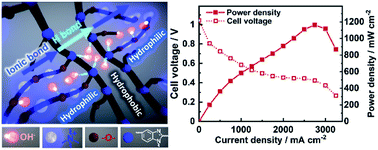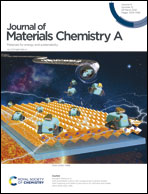Ultra-thin quaternized polybenzimidazole anion exchange membranes with throughout OH− conducive highway networks for high-performance fuel cells†
Abstract
A hydrophilic–hydrophobic microphase separation structure is essential for anion exchange membranes (AEMs) to balance ion conduction and mechanical strength. However, continuous hydrophobic microphase will inevitably become a barrier for ion conduction between dispersed hydrophilic ionic clusters. In this study, throughout ion conductive highway networks are constructed in quaternized polybenzimidazole (PBI) AEMs, in which OH− could break through the hydrophobic polymer backbone by forming dense hydrogen bond networks with pyridine nitrogen (–N![[double bond, length as m-dash]](https://www.rsc.org/images/entities/char_e001.gif) ) in PBI repeating units, and a tri-cationic/non-cationic ether pendant side chain is proposed to greatly improve ionic aggregation that was still difficult to achieve in reported quaternized PBI membranes. The molecular dynamics simulation indicates comparable OH− coordination through ionic bonds in hydrophilic microphase and hydrogen bonds in the hydrophobic microphase. The as-prepared membranes exhibit excellent toughness to fabricate ultrathin self-supporting AEMs (10 μm) with low ohmic resistance. H2/O2 fuel cells achieves a high peak power density of about 1162.3 mW cm−2 at a large current density of 2749.5 mA cm−2, which is the highest value among recently reported PBI-based AEMs and multi-cation side-chain type AEMs. The design of throughout conductive highway network makes the highly stable commercial PBI material one of the best candidates for AEMFCs.
) in PBI repeating units, and a tri-cationic/non-cationic ether pendant side chain is proposed to greatly improve ionic aggregation that was still difficult to achieve in reported quaternized PBI membranes. The molecular dynamics simulation indicates comparable OH− coordination through ionic bonds in hydrophilic microphase and hydrogen bonds in the hydrophobic microphase. The as-prepared membranes exhibit excellent toughness to fabricate ultrathin self-supporting AEMs (10 μm) with low ohmic resistance. H2/O2 fuel cells achieves a high peak power density of about 1162.3 mW cm−2 at a large current density of 2749.5 mA cm−2, which is the highest value among recently reported PBI-based AEMs and multi-cation side-chain type AEMs. The design of throughout conductive highway network makes the highly stable commercial PBI material one of the best candidates for AEMFCs.



 Please wait while we load your content...
Please wait while we load your content...